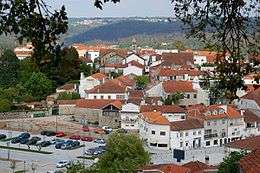António Luís Costa
António Luís Costa (Santa Comba Dão, Portugal, 1953) is an ex-GNR soldier and serial killer from Santa Comba Dão, Portugal. He was convicted in 2007 for the murders of three young women between May 2005 and May 2006. He is currently held in the prison of Évora.[1]
António Luís Costa | |
|---|---|
| Born | 1953 Santa Comba Dão, Portugal |
| Criminal penalty | 25 years imprisonment |
| Details | |
| Victims | 3 |
Span of crimes | 2005–2006 |
| Country | Portugal |
Date apprehended | June 24, 2006 |

Murders
Costa's first victim was Isabel Cristina Isidoro, who went missing on May 24, 2005; her body was recovered from the ocean on May 31, 2005.[2] Mariana Lourenço went missing on October 14, 2005, and her mutilated body was found in June 2006.[2] The third and last victim was Joana Oliveira, who went missing on May 8, 2006; her body was recovered from under a bridge based on directions given by Costa.[2] According to Costa, after he had consensual sexual relations with the first victim and asked for a kiss from the second and third victims, he suffocated them when they threatened to tell.[3][4]
Arrest and confession
Costa was arrested by the Polícia Judiciária (PJ) on June 24, 2006. At first, he confessed the crimes, both to the police and to the judge conducting the preliminary investigation. He later withdrew his confession and accused an uncle of Lourenço for the crimes.[2][5] He claimed police coerced him into confessing, an accusation refuted by the PJ.[6][7] Costa's telephone was tapped, and he was recorded confessing the crimes to his family.[5][8]
Trial
Costa's trial began on July 4, 2007; he was charged with three murders, three crimes of hiding the body, one crime of profaning the body (for undressing a body),[3][9] two crimes of attempting sexual coercion, and one crime of calumnious denunciation (for accusing Lourenço's uncle of the crimes[9]). During the trial, Costa claimed his innocence and remained silent except for the first and last court sessions.[2]
The Ministério Público asked for a sentence of 25 years in prison, the maximum allowed under Portuguese law, and said the only reason they did not ask for more is because it is not possible.[2] The prosecution said Costa acted on a sexual impulse and that from the start, he tried to be considered insane as a means of escaping trial; however, two psychiatric examinations found Costa to be sane enough to stand trial.[2]
The defense said psychiatric examinations found no psychopathy and no promiscuous sexual behaviour.[2][10] In addition, the defense claimed the rights of the defendant were not respected because he was treated as a guilty psychopathic serial killer.[2] The defense said the testimony given by witnesses may not be reliable because of inconsistencies and discussion of the case among witnesses.[2][10] The police investigation was criticized by the defense, which claimed some persons were not investigated enough.[2]
On July 31, 2007, the court found Costa guilty of all charges except for the crime of hiding Isidoro's body, since she was still alive when she was thrown into the Atlantic Ocean.[11] Costa was sentenced to 64.5 years in prison,[9] reduced to 25 years, the maximum penalty under Portuguese law. His defense announced they will appeal the conviction.[12]
On June 18 2020, Costa was denied parole.[13]
Media coverage
The case received extensive media attention in Portugal. It was front page in some newspapers.[14][15][16]
Maximum penalty criticism
The case raised some criticisms towards the Portuguese rule that sets 25 years in prison as the maximum penalty. Some people argued that more severe sentences should be allowed.[17][18][19]
References
- Franco, Hugo; Moleiro, Raquel; Gustavo, Rui (25 November 2014). "Os vizinhos de Sócrates na prisão" [Sócrates's prison neighbours]. Expresso (in Portuguese). Retrieved 13 May 2016.
- Diário de Coimbra
- PortugalDiário - A informação actualizada ao minuto: as últimas notícias do país e do mundo Archived August 12, 2007, at the Wayback Machine
- asbeirasonline Archived September 27, 2007, at the Wayback Machine
- asbeirasonline Archived September 27, 2007, at the Wayback Machine
- "'Quarta vítima' é peça-chave na acusação contra "serial killer"" (in Portuguese). Diário de Notícias. Archived from the original on 2007-06-06.
- Sol
- http://expresso.clix.pt/Actualidade/Interior.aspx?content_id=397768
- Correio da Manhã
- Sol
- Sol
- "Diário Digital". Archived from the original on 2011-09-29. Retrieved 2018-07-28.
- "Serial Killer de Santa Comba Dão vê saída precária recusada. Ex-militar da GNR cumpre mais de metade da pena". jornaldocentro.pt (in Portuguese). Retrieved 2020-06-20.
- http://www.correiodamanha.pt/noticia.asp?id=252344&idCanal=20
- DIÁRIO DE NOTÍCIAS - Capa DN Quarta-feira, 1 de Agosto de 2007
- https://jn.sapo.pt/2007/08/01/imagens_jn/cpais.jpg%5B%5D
- Correio da Manhã
- Correio da Manhã
- "SondagensPT - onde o teu voto conta". Archived from the original on 2007-09-28. Retrieved 2007-08-17.